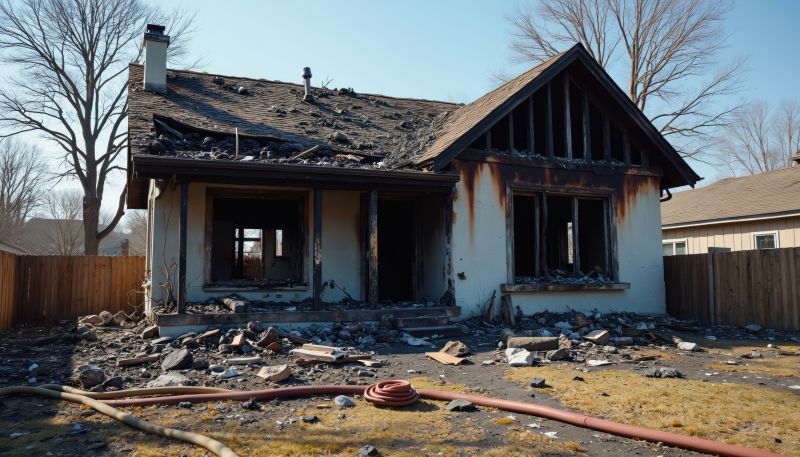Leading Fire Restoration Solutions To Help Rebuild And Recover
Utilize proven products designed to assist in the efficient rebuilding process after fire incidents.
 Fire restoration is a critical process that involves cleaning, repairing, and restoring properties affected by fire damage. The right products play a vital role in ensuring that surfaces are properly cleaned, odors are neutralized, and structural integrity is maintained. From soot removers to specialized cleaning agents, a variety of tools and materials are available to assist professionals and homeowners alike in managing fire-related damages effectively.
Fire restoration is a critical process that involves cleaning, repairing, and restoring properties affected by fire damage. The right products play a vital role in ensuring that surfaces are properly cleaned, odors are neutralized, and structural integrity is maintained. From soot removers to specialized cleaning agents, a variety of tools and materials are available to assist professionals and homeowners alike in managing fire-related damages effectively.
Top Overall Option
Multi-Purpose Fire Damage Cleaning Kit
A comprehensive cleaning kit designed to address soot, smoke, and residue removal across various surfaces. It includes specialized cleaners, deodorizing agents, and protective gear to facilitate effective and safe fire restoration efforts.
Types of Products For Fire Restorations
Soot Removers
Products formulated to safely and effectively remove soot deposits from walls, ceilings, and other surfaces.
Smoke Odor Neutralizers
Solutions designed to eliminate lingering smoke odors from indoor environments.
Cleaning Agents for Surfaces
Specialized cleaners suitable for various materials including wood, metal, and fabric affected by fire.
Air Scrubbers and Purifiers
Equipment used to filter airborne contaminants and improve indoor air quality during restoration.
Protective Gear
Masks, gloves, and suits to ensure safety during cleaning and repair activities.
Deodorizing Sprays
Sprays that help mask or neutralize odors caused by smoke and soot.
Moisture Meters
Tools to assess moisture levels in walls and floors to prevent secondary damage.
Thermal Foggers
Devices that disperse deodorizing agents deeply into affected areas for thorough odor removal.
Vacuum Systems
High-efficiency vacuums designed to extract soot and debris from surfaces and air filters.
Cleaning Wipes and Cloths
Pre-moistened wipes and durable cloths for quick spot cleaning and surface wiping.
Sealants and Primers
Materials used to seal surfaces and prevent smoke odors from penetrating further.
Fire-Resistant Paints
Specialized paints that can be applied to surfaces to enhance fire resistance and reduce future damage.
Structural Repair Materials
Patching compounds, adhesives, and reinforcements for damaged structural elements.
Water Damage Restoration Products
Products to address water intrusion that often accompanies fire suppression efforts.
HVAC Cleaning Products
Solutions for cleaning and disinfecting heating, ventilation, and air conditioning systems.
Fire Suppression Equipment
Tools and agents used to extinguish fires and prevent further damage during initial response.
Popular Choices
Gels that absorb and neutralize smoke odors in enclosed spaces.
Convenient wipes for quick soot removal from surfaces.
Portable air purifiers equipped with HEPA filters for removing airborne particles.
High-efficiency vacuums for cleaning soot and fine debris.
All-in-one kits containing multiple products for comprehensive cleanup.
Powerful cleaning solutions suitable for heavy-duty soot and grime removal.
Decorative beads infused with odor neutralizers for continuous air freshening.
Tools that attract and remove soot particles from surfaces.
Devices that disperse deodorizing agents to eliminate persistent smoke odors.
Disposable coveralls for safe handling of contaminated materials.
Sprays formulated to treat and restore fire-affected surfaces.
Tools for identifying hidden moisture in walls and floors.
Sealants that lock in odors and prevent further penetration.
Materials used to reinforce structural elements against future fire hazards.
Heavy-duty units for large-scale air purification during restoration.
Specialized sponges for removing soot without smearing.
Sprays that neutralize odors at the source.
Proper fire restoration begins with assessing the extent of damage and selecting appropriate products tailored to different surfaces and materials. Soot and smoke residues can cling to walls, ceilings, furniture, and HVAC systems, requiring targeted cleaning solutions. Odor elimination is also a key component, often involving the use of specialized deodorizers and air scrubbers. The selection of products must consider safety, compatibility with affected materials, and effectiveness in removing contaminants without causing further harm.
In addition to cleaning agents, fire restoration involves the use of protective gear such as masks, gloves, and suits to ensure safety during the cleanup process. Equipment like moisture meters and air scrubbers help monitor progress and improve indoor air quality. It is essential for restoration professionals and DIY enthusiasts to understand the variety of products available and how they can be combined for optimal results. Proper training and knowledge about product application can significantly enhance the restoration process, reducing the risk of secondary damage and ensuring a safer environment for occupants.
Key Buying Considerations
- Identify the specific surfaces and materials affected to choose appropriate products.
- Consider the severity and extent of fire and smoke damage for selecting cleaning agents.
- Ensure products are compatible with the materials being restored to prevent further damage.
- Opt for products with clear instructions and safety guidelines for effective use.
- Evaluate the safety features of protective gear and ensure proper fit and comfort.
- Assess the size and capacity of equipment like air scrubbers and foggers to match your needs.
- Look for products that offer odor neutralization without masking smells with fragrances.
- Check for ease of application and removal to streamline the restoration process.
- Prioritize products that are suitable for use in occupied spaces if necessary.
- Consider the environmental conditions of the property, such as humidity and ventilation.
- Review product shelf life and storage requirements to ensure longevity and safety.
- Research compatibility with existing cleaning routines or restoration protocols.
- Determine if professional-grade equipment is necessary or if DIY solutions suffice.
- Evaluate customer reviews and expert opinions for insights on product effectiveness.
- Ensure availability of replacement parts or refills for ongoing restoration efforts.
